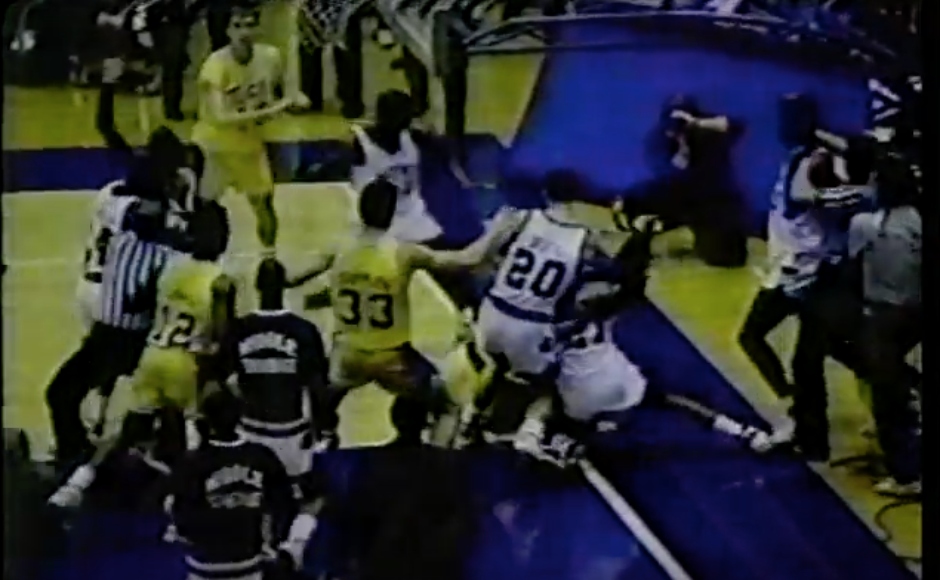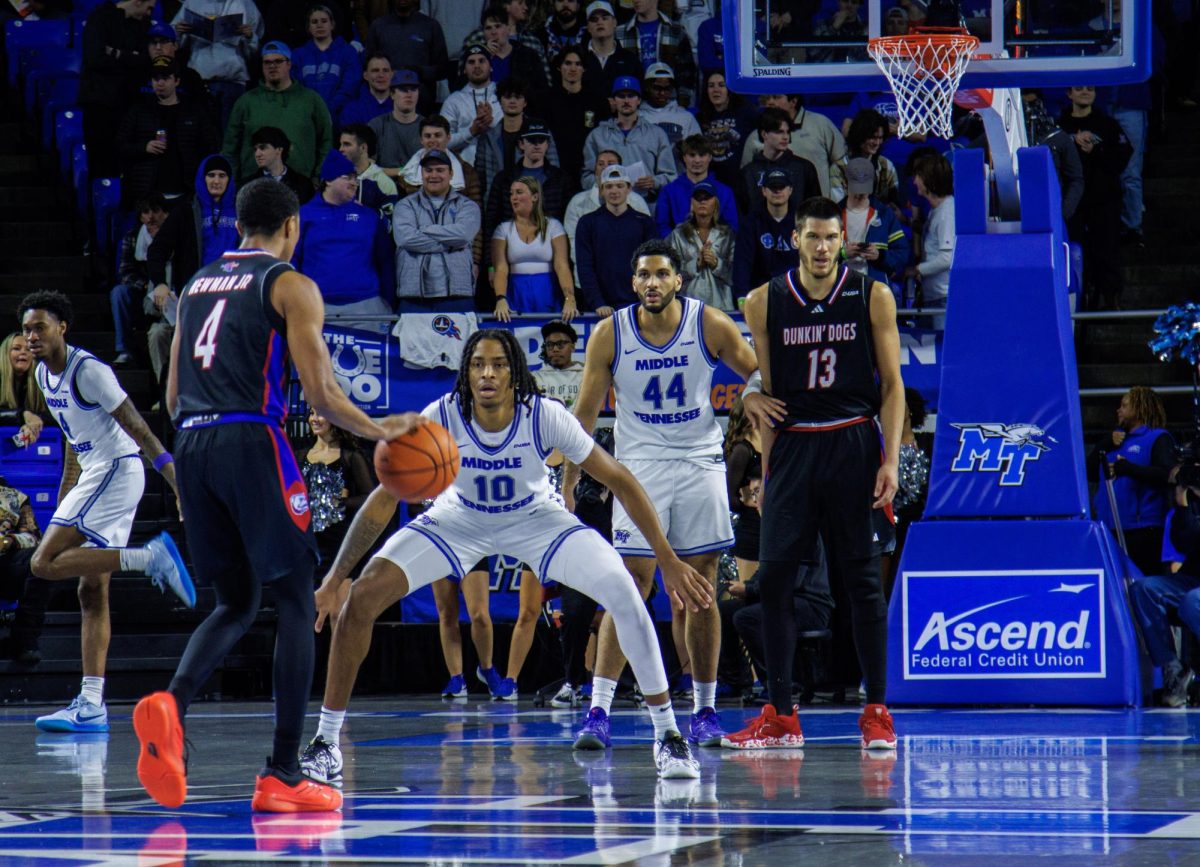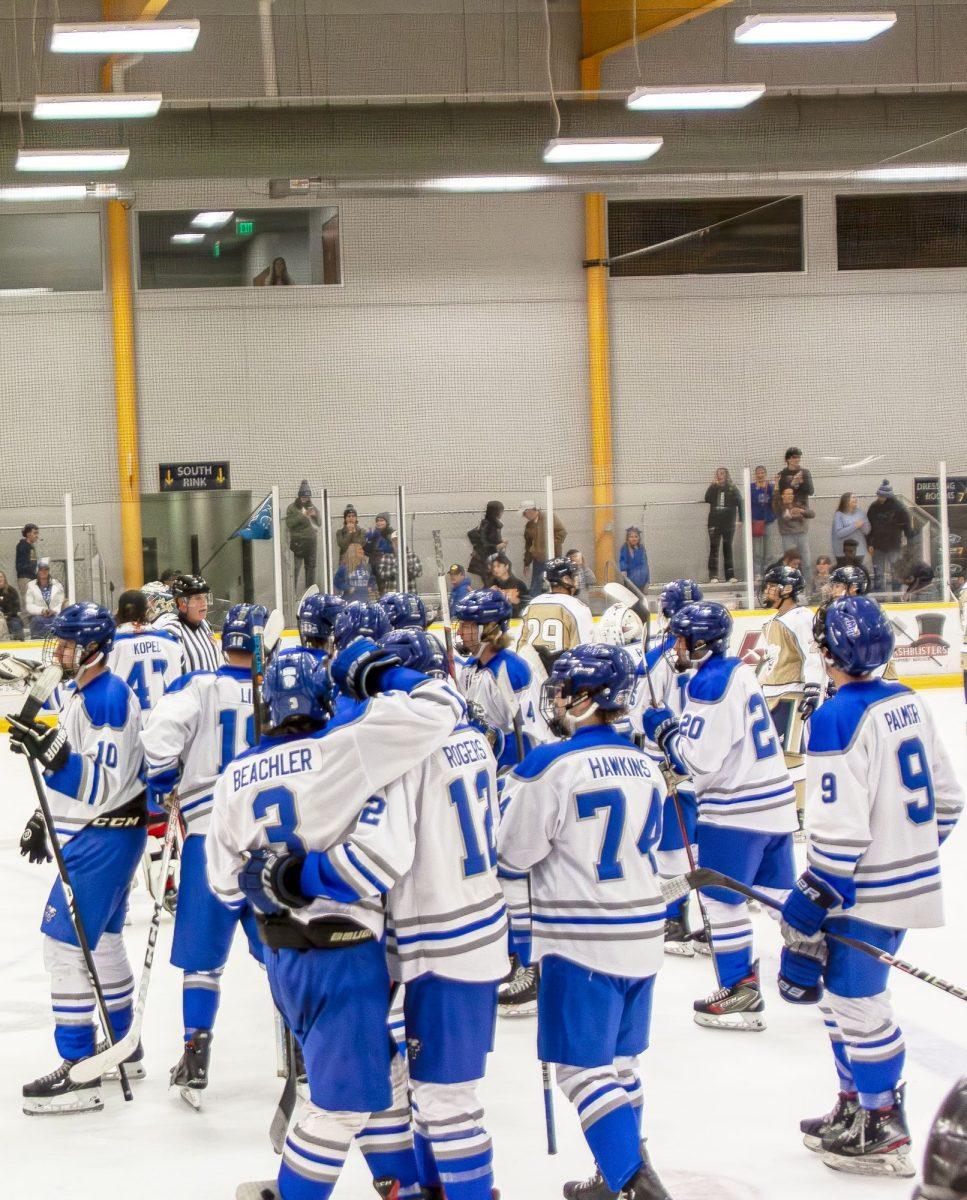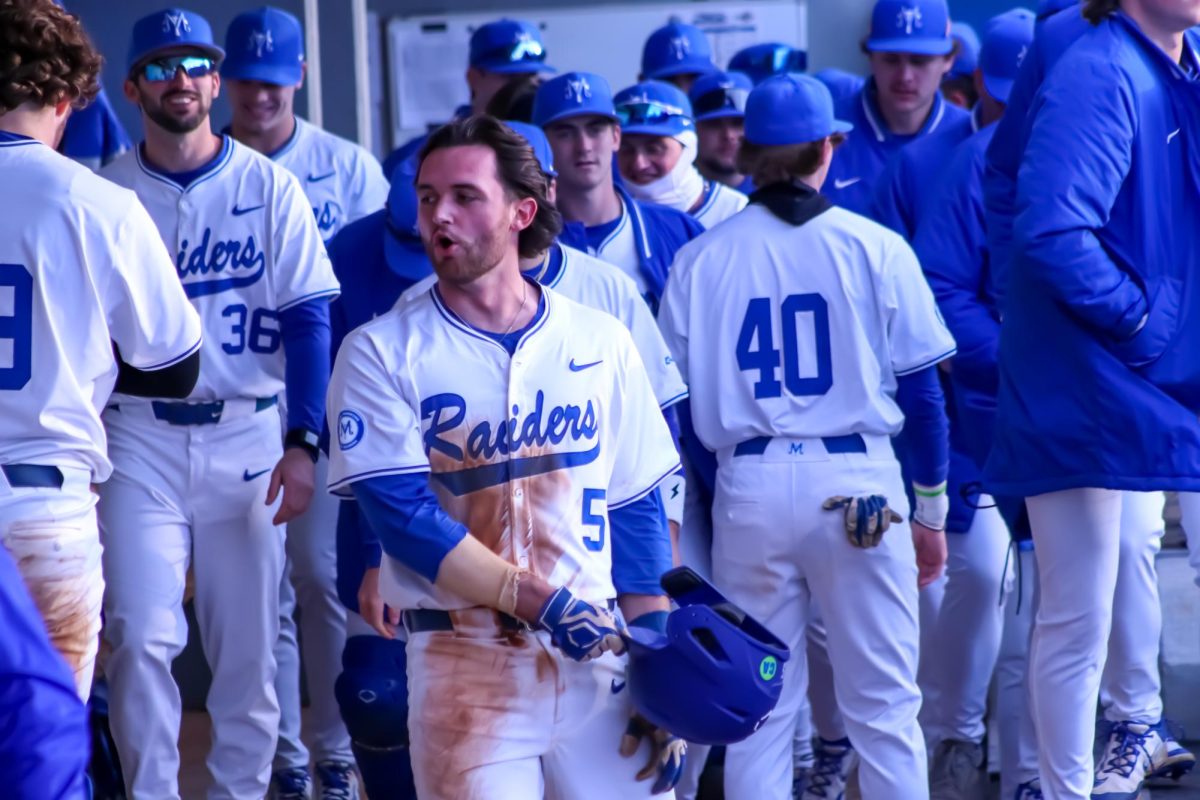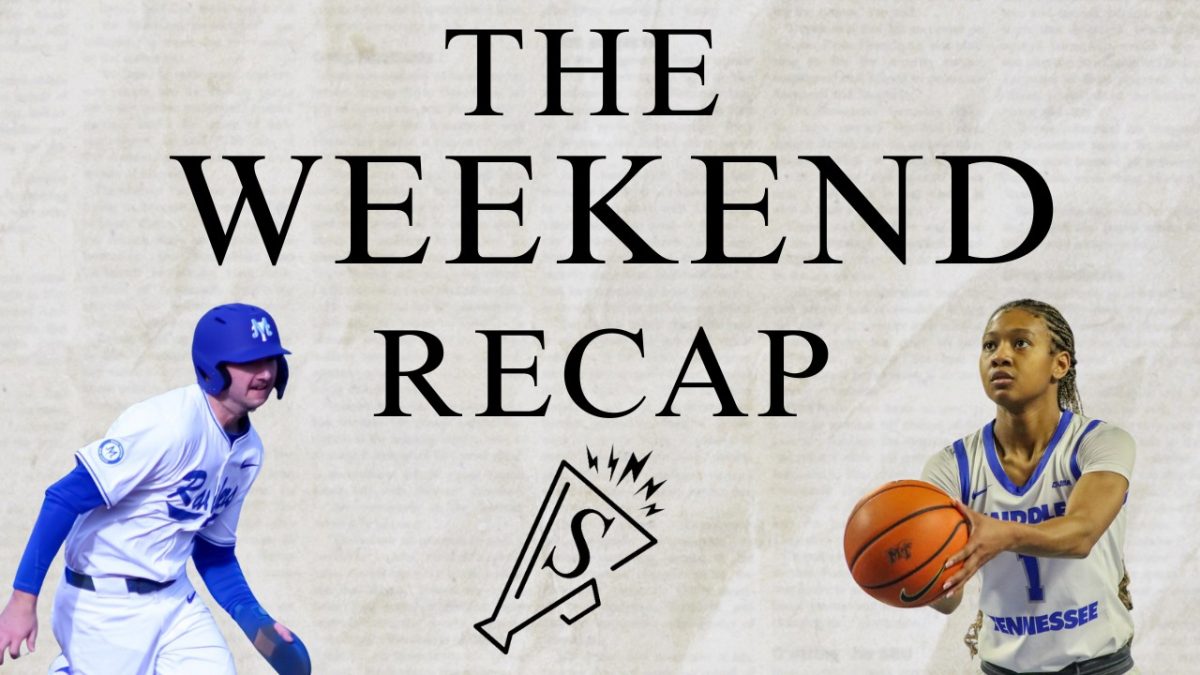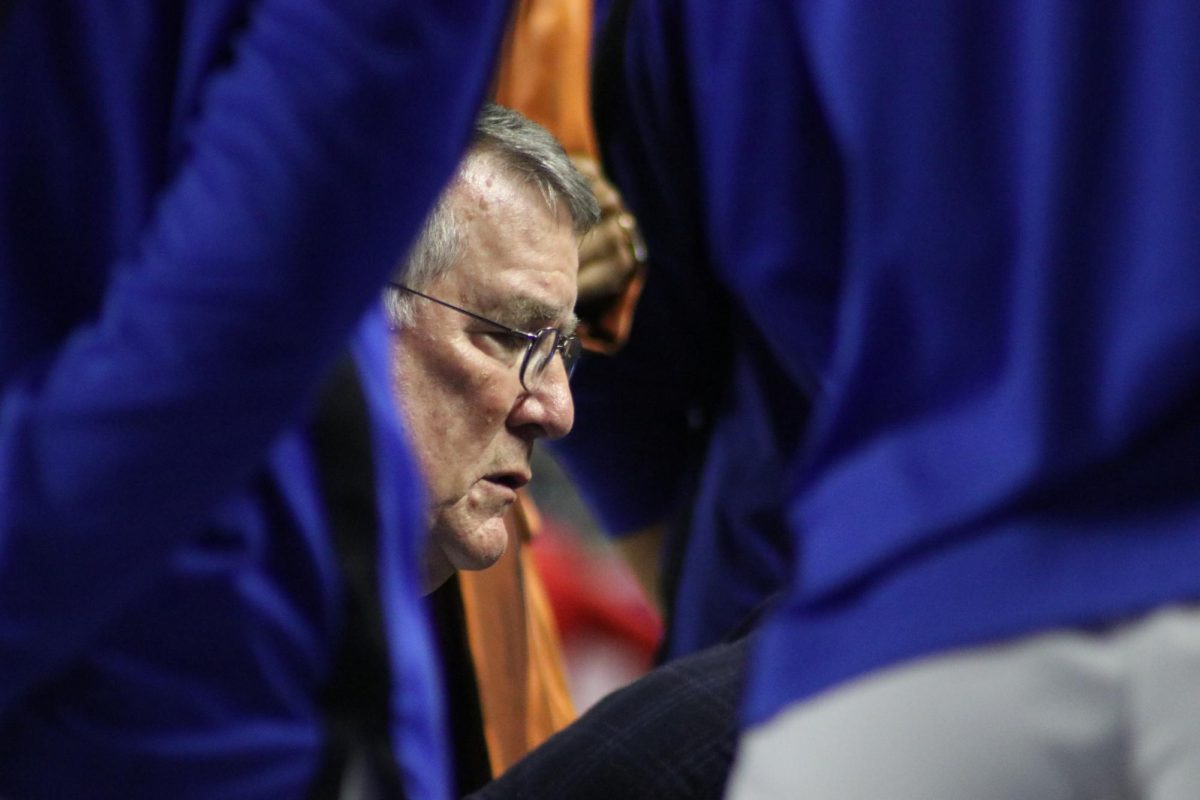Photo courtesy of JackNtheVideoBox / YouTube
Well before Middle Tennessee State and Western Kentucky pinned each other as their top basketball rivals, Middle Tennessee and Tennessee Tech had a rivalry so fierce and so heated that games between them often got physical. On multiple occasions, fights broke out, including one that is now known as “The Melee in Murfreesboro.”
Before one can jump into the infamous televised fight of 1990, it’s important to understand the pure disdain the two schools had for each other. This decades-long rivalry didn’t just stem from players being on-court adversaries that simply jockeyed for bragging rights and positioning in the standings of the Ohio Valley Conference year in and year out.
These two schools, separated by only 65 miles, had a unique rivalry spanning decades. Tennessee Tech fans and students often referred to MTSU as “Middle Tennessee High School,” mascots fought during football games and students of both schools were notorious for stealing the wooden totem pole trophy (one that MTSU students named “Harvey” while Tech students still refer to it as “Shinny-Ninny” and was annually awarded to the winner of the MTSU-Tennessee Tech football rivalry) from each other’s trophy case.
Rivalry between coaches
Not only were these teams heated rivals, but the coaches were too. Former Tennessee Tech head coach Tom Deaton and former MTSU head coach Bruce Stewart were well-known adversaries and in many instances, couldn’t even be in the same room as one another.
“They really didn’t like each other, and I don’t know why,” recalled Frank Harrell, a former Tech head coach and assistant on Deaton’s staff. “They didn’t even talk … They didn’t have any respect for each other.”
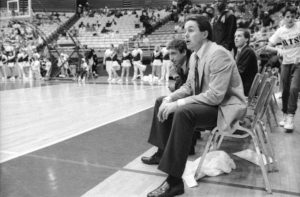
During OVC media days one season, Stewart decided to indirectly push some of Deaton’s buttons. While at the podium, he told a group of reporters a fictional story about him and Deaton working at Fruit of the Loom and pitching sales ideas. Stewart, who often joked with the media, said he suggested the company should sell underwear in packs of seven.
Why seven? a reporter asked.
Stewart answered that it would give him a clean pair for Monday, Tuesday, Wednesday, etc.
Stewart followed that up by stating that Deaton’s suggestion was even more strange and that he pitched they sell underwear in packs of 12. A different reporter asked why he would specifically pitch packs of 12. Stewart claimed that Deaton’s reasoning was so that he would have one for January, February, March, etc.
According to one of Stewart’s former MTSU grad assistants, Kyle Turnham, the media found the story hilarious.
“Bruce told that story, and the place just erupted with laughter. It made Tom so mad. He was just furious,” Turnham said. “Bruce always knew that he could get to Tom.”
Turnham still believes that the feud between the two coaches was more one-sided than what the public perceived.
“I always felt like Tom Deaton disliked Bruce Stewart much worse than Bruce Stewart disliked Tom Deaton,” Turnham recalled after coaching under Stewart for four years. “I don’t think Bruce was a fan of Tom Deaton’s but I always sensed Tom disliked Bruce more.”
The coaching rivalry, as well as the rivalry between the two teams, reached a fever pitch on Jan. 6, 1986, at the Hooper Eblen Center in Cookeville.
The first fight between Tech and MTSU
Before that game, Harrell was well aware of the physical brand of basketball that MTSU players established.
“When you watched Middle on film, there was always an extra elbow thrown or something like that,” Harrell recalled.
Tech even marked on their scouting report that it was vital to not retaliate to MTSU’s physicality and to avoid intimidation.
But on that night in 1986, the scouting report was ignored. The scuffle started after Tech forward Jon Miller fouled
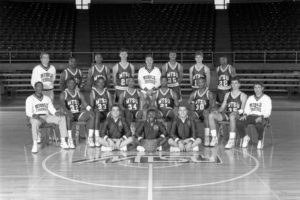
Blue Raider guard Kim Cooksey hard along the baseline with four seconds left until halftime. According to witnesses (since the fight was never captured on film), Cooksey gave a slight shove to Miller while on the ground. When both players got back to their feet, Miller connected on a haymaker punch, despite the referee’s efforts to separate the two.
“Just when you were thinking, ‘Ok, this incident is over,’ Miller reaches around and takes a swing at Cooksey. He connects and that’s when all Hades breaks loose,” Turnham said.
Once the first punch was thrown, both benches cleared and a brawl broke out. The fight spilled over toward the stands, and some fans became involved. Harrell claimed that after the game, a certain number of fans owned up to their role in hitting MTSU players when the scuffle spilled out toward the fan seating area.
“If you were a Middle Tennessee basketball player, you were dealing with the Tech player that you were fighting from in front as well as the Tech fans you had to deal with from behind,” Turnham, a student assistant at this time, recalled.
After the fight subsided, both teams had to recollect themselves and play the final four seconds of the half. However, with the Eblen Center only having one tunnel for both teams to walk back to their locker rooms to merely minutes after a large fight broke out, round two was just bound to happen.
According to Turnham, MTSU waited for Tech to go into the tunnel and toward their locker room first. When MTSU went into the tunnel, they were greeted by other Tech players outside their locker room (which was only separated from MTSU’s by about 15 feet), and a second fight broke out during halftime.
The close proximity of the locker rooms and the lack of space in the narrow Eblen Center tunnel made for a scarier fight than the one that spilled out along the baseline during the first half.
“You’re dealing with walls and being enclosed, and you’ve got a bunch of strong men and it’s every man for himself,” Turnham remembered. “Those were two brutal fights. You were getting hit from all parts and everyone was involved … It felt like it was never going to end.”
The feuding head coaches were involved, Turnham said.
“I remember looking up and seeing Coach Stewart and Coach Deaton had each other by the tie and were involved in their own individual battle … It was the wildest thing I’ve ever seen.”
The fight eventually subsided, and the second half was played without further incident. Stewart and his Blue Raider team escaped Cookeville with a 79-77 victory.
Miller was suspended two games for initiating the fight and was told by Jim Delany, the OVC commissioner, that Cooksey’s initial hit on him was “a bee sting” and that his retaliation punch was “an A-Bomb”.
For MTSU, Cooksey and teammate Kerry Hammonds were suspended one game each for their roles in the fight.
The Blue Raiders finished that season 23-11, and in the following years, they would experience dominance over their archrival and an abundance of success in the OVC as well as the NCAA Tournament. MTSU won their next seven games against Tech, some of which were not close.
The Blue Raiders finished second in the OVC in 1986 and won the OVC regular season title in 1987. After getting beat by Austin Peay in their first game of the OVC Tournament in 1987, they still got an at-large bid to the 1987 NCAA Tournament, the only team in OVC history to receive such bid.
In March of 1989, Stewart and his Blue Raiders won the OVC regular season title, the OVC Tournament and for the first time since Stewart became MTSU’s head coach, won an NCAA Tournament game when they upset fourth-seeded Florida State 97-83.
The Blue Raider basketball program was riding one of the most successful stretches in program history.
The Melee in Murfreesboro
Sitting in the stands of the Eblen Center during the night of the 1986 fight was high school freshman Mike Buck. Buck was a basketball standout of his own at Clarkrange High School, a small school only 31 miles from Cookeville and was at the game to watch as a fan and spectator.
“Being from around there, I was more familiar with the Tech players than I was with the Middle players,” Buck said. “Watching (Dwayne) ‘BamBam’ Rainey and Kerry Hammonds and all those big dudes out there fighting was crazy. As a kid, I was all big-eyed out there watching it. Who knew that a few years later, we’d be doing it again.”
Despite being a high school basketball standout only 31 miles from Cookeville, Buck wasn’t offered a scholarship by Tennessee Tech. Harrell, who at this time had become the head coach at Tech after Deaton abruptly resigned five games into the 1988-1989 season, claimed that his team didn’t have a need to sign another shooting guard onto the roster but still admired Buck as a player and felt that Stewart recruited him to play at MTSU as a slight toward Tech.
“He’s one of my favorite players of all time,” Harrell said about Buck. “We didn’t recruit him because we felt like we didn’t really need his position. At one time, I thought Middle took him to make Tom look bad. But, Mike ended up being a pretty decent player for Middle. He helped them out quite a bit.”
In his freshman season, Buck’s historical performance against Florida State in the first round of the 1989 NCAA Tournament propelled the Blue Raiders to a shocking upset as he shot a perfect 7-7 from the field, 6-6 from the three-point line and 6-6 from the free throw line to give him 26 points in only 22 minutes off the bench.
The following season was one of rebuilding for Buck and the Blue Raiders. They got off to a rocky start in non-conference play, winning only two of their first 10 games before entering OVC play.
Following a tough road trip that saw four consecutive losses, the Blue Raiders were desperate to get back on track with a win at home against their archrival.
“It was a time where Coach Stewart was encouraging us to be really aggressive and really physical,” Buck said. “With Tech being our first game back (from the road trip), we were really on edge.”
Turnham, who at this time was promoted to graduate assistant on Stewart’s staff, believed this early season frustration contributed to the tension around the team that eventually spilled out onto the basketball floor.
“We were not accustomed to losing,” Turnham said. “The combination of losing and the way we were losing, not being as physical or as tough as we have been, certainly caused us as a coaching staff to challenge the players to be tougher … I do think that the challenge of getting tougher, physically and mentally, was a subliminal thing that relates to the fight.”
Tech came into the early January match-up with MTSU on a roll. Harrell and his team won seven of their first 10, including wins against Auburn on a neutral floor and Vanderbilt on the road, but according to Harrell, he was personally motivated to beat MTSU because of a statement that Stewart made to the Daily News Journal earlier that week.
“I remember my pregame speech,” Harrell recalls. “I told my team that, when asked about his record, Bruce said that it’s ok because Tech was coming up and, ‘We always beat Tech.’ So that was my pregame speech.”
With 10:31 remaining until halftime, Buck slightly shoved Tech forward Milos Babic on the hip after he was fouled by Blue Raider forward Quincy Vance.
“The shove and the reason for my push on the hip was that Milos had a really good first segment of that game. He had 12 or 14 points and about five or six rebounds. He was really playing well,” Buck said. “On the catch, Quincy fouls him from behind and the refs call the foul. Well, the whistle had already blown, and he does this little move and takes a shot on our home court after the whistle is blown so I just kind of tapped him on the hip as to kind of say, ‘Give the ref the ball, the play is dead, stop on the whistle’… That’s when he turned to Quincy, thinking it was him.”
Babic and Vance exchanged pleasantries before simultaneously shoving each other. Buck then entered the fray, shoved Babic before Babic was met with two punches from two different MTSU players, sending Babic and his seven-foot frame falling to the ground. Once Babic was punched, the benches instantly cleared and all hell broke loose, sparking the brawl that is now known as The Melee in Murfreesboro.
One of the players who left the bench to join the fight was Bue Raider center David Clark. Clark remembers the fight and the physical toughness his team had as well as the “no lay-up rule” that Stewart installed into his teams. However, Clark didn’t predict the fight would get as out of hand as it did.
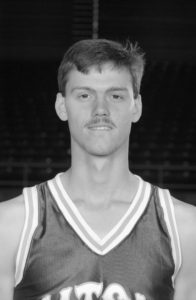
“I look back at the video, and I see just how minor it was when Mike Buck pushed the guy in the hip and he thought that Quincy Vance did it. So it just happened incidentally,” Clark recalled. “We played hard, but it just kind of happened in a random way and because of the intensity of how we practice and how we played. It just kind of spawned off on the floor.”
As soon as Clark and his teammates left the bench, Turnham knew he had to do what he could to avoid things getting out of hand the same way it did at Tech just four years earlier.
“I was trying to get players who were on the perimeter of the fight back to the bench,” Turnham said. “They were coming from their bench, so there were all kinds of players coming from the left, coming from the right and it was just all over the place.”
As soon as the fight appeared to slow down, Buck found a Tech player who was facing the Blue Raider bench and punched him from behind, landing a shot squarely in the back of the head, which caused the fight to reignite.
“We joked about this afterward because it wasn’t really funny when it happened, that for whatever reason, Coach Stewart went and grabbed Quincy Vance and was holding him from behind, keeping his arms down. We joked with coach that he obviously hasn’t been in too many fights because you don’t hold your guys arms down,” Turnham chuckled. “But as coach was holding Quincy, Tennessee Tech had a manager that cold-cocked Quincy while Coach Stewart was holding him.”
That Tech student manager was named Jason Craighead. Craighead ran off the Tech bench and became involved in the scuffle when the fight shifted toward the corner of Murphy Center. With Stewart holding Vance’s arms down, attempting to get him away from the fight, Craighead delivered a right-handed punch to the face of Vance.
After Craighead punched Vance, he started backing away only to be blindsided by a punch from MTSU guard Titus Jackson, who was not even in the frame of the footage of the fight. Vance came flying in on a dead sprint with his right hand balled up in a fist and sent Craighead straight to the floor, sending papers that was on his clipboard flying through the air.
This was the point of the fight when Buck felt that everything was out of control.
“I don’t know if I ever felt like it was going to turn into something major … Whenever you saw people in street clothes getting hit, when it gets to that point, I guess the fear or the will within kind of creeps in and needs to stop pretty soon,” Buck said. “It had a crazy feel to it, the whole game did.”
The fight eventually ended. Babic and Tech’s leading scorer Earl Wise were ejected and for MTSU, Clark, Vance and Kevin Wallace were sent to the locker rooms early. Buck stayed in the game, and Tech went on to beat MTSU 100-75.
The aftermath
The game was televised on ESPN and just so happened to be during the NCAA convention, where OVC commissioner Dan Beebe and other athletic directors from the OVC watched the game at a restaurant. This led Harrell to speculate that the pressures from other athletic directors led Beebe to hand out what Harrell felt were excessively harsh punishments.
Wise and Babic were suspended two games each for their role in the fight, but a member of the Tech staff that got the harshest punishment (five games), was Craighead, the student manager.
Beebe told Harrell that because Craighead was in street clothes, that he should have remained on the bench. Harrell aggressively tried to get Craighead’s suspension appealed because he believed that he was just as much a part of the team and the fight that his other players were.
“What am I supposed to do? Not let him wash clothes for five games?” Harrell asked Beebe.
The Blue Raiders had eight players suspended by the OVC, including Buck who was suspended four games by the league and two by Stewart.
Of all the players involved, it was Buck who was made out to be the scapegoat. After the game, Stewart told Sidelines, “Because of Mike’s irrational behavior, we lost three good inside players and the game.”
Harrell disagreed with how Buck was treated after the fight and how he received all the blame for how things transpired that night.
“I thought Bruce threw Mike under the bus. He made him a culprit more so than what he really was.”
Buck still talks with some of his old teammates and some members of the Murfreesboro community and to this day, his role in the fight overshadows some of his other career accomplishments, such as his perfect shooting game against Florida State the year before.
“It’s weird,” Buck said about his legacy at MTSU. “Everybody that I talk to from Middle at that time brings up one of two moments from that four-year window of my life. It’s either the NCAA Tournament or the fight. I kind of wish one would go away.”
Buck claims that now that the video of the fight has resurfaced on YouTube, the incident has become harder to escape. While his son has shown the video to a few of his friends, he still isn’t proud of that moment in his life.
Stewart also received public criticism for declining Beebe’s offer of letting him stagger the suspensions to avoid forfeiture of any games and instead, choosing to forfeit their game at Tennessee State on Martin Luther King Day (one of TSU’s most financially profitable games in terms of ticket sales).
Some who covered the Blue Raiders at the time, like current MTSU women’s basketball sports information director, Tony Stinnett, believes that Stewart’s handling of the suspensions and the press conference he held to announce he was forfeiting the TSU game were the dominoes that fell in place to cause Beebe to look deeper into accusations of Stewart’s recruiting practices that were rumored to be shady.
“It all goes back to that press conference,” Stinnett said. “That was the beginning of the end.”
During some of the player suspensions, a pair of MTSU football players filled in and played valuable minutes. Mike Caldwell, who is now the linebackers coach for the Tampa Bay Buccaneers, and Kenny Tippens, who was on the Dallas Cowboys developmental squad, played in several games while the eight Blue Raiders were suspended.
MTSU finished the season with a 12-15 record and had a losing record in OVC play as well. The NCAA eventually opened an investigation into Stewart and some of his recruiting practices and illegal off-season high school camp activities, some of which were reported to the NCAA by Harrell.
“We (Tech) had a huge camp, and at the same time, Bruce started his camp,” Harrell, who now works as the associate athletic director and head of compliance at Tennessee Tech, recalled in his office at the Eblen Center. “But he started paying high school coaches to have their team camp there, paying them $50 per player, and that was against NCAA rules.”
Harrell reported it to the NCAA and believes that Stewart always resented him for it.
Stewart resigned after the following season, and the NCAA dropped the hammer on MTSU, putting them on probation as well as taking away athletic scholarships and banning them from postseason play.
The Blue Raiders wouldn’t make it back to the NCAA Tournament until 2013.
Stewart finished his coaching career at Northwest Florida State College, where he coached from 1997-2010. Stewart died of brain cancer in 2011 in Ft. Walton, Florida, and despite the heated rivalry between the two schools, Harrell donated money to the charity in Stewart’s name, the Stewart Children College Fund.
But the rivalry still hasn’t left Harrell’s spirit as he concluded his interview for this story with one last anecdote.
“To this day, I only have two teams that I cheer for in sports. One is Tennessee Tech, the other is whoever plays Middle Tennessee.”


